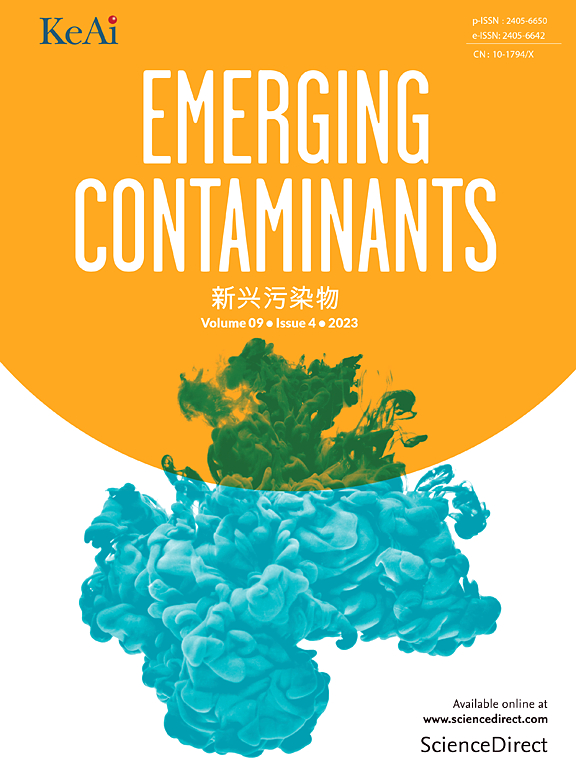Gadolinium exposure in Procambarus clarkii: tissue-specific bioaccumulation and oxidative stress responses
IF 6.9
2区 环境科学与生态学
Q1 ENVIRONMENTAL SCIENCES
引用次数: 0
Abstract
Gadolinium (Gd), a rare earth element widely used in medical imaging and industry, is increasingly detected in aquatic environments. This study examines tissue-specific bioaccumulation and antioxidant responses in Procambarus clarkii following exposure to environmentally relevant Gd concentrations (0.1, 1, 10, and 100 μg/L) over 14 days. Bioaccumulation was evident in the gills and hepatopancreas at higher exposure levels (10 and 100 μg/L), whereas muscle concentrations remained below the limit of quantification. Oxidative stress responses varied by tissue, with no clear trend revealed by the non-metric multidimensional scaling (NMDs), suggesting limited antioxidant activation likely due to low Gd accumulation and short exposure duration. However, superoxide dismutase (SOD) activity significantly increased in the gills and hepatopancreas at higher Gd concentrations. In contrast, glutathione peroxidase (GPx) activity showed inconsistent trends, while glutathione S-transferase (GST) activity was elevated in hepatppancreas and muscle only at 0.1 μg/L. Lipid peroxidation was most pronounced in the gills. The Integrative Biomarker Response-Threshold (IBR-T) index revealed low-dose effects consistent with hormetic responses, highlighting biologically relevant alterations observed at the lowest Gd concentrations. These findings suggest that P. clarkii exhibits tissue-specific Gd bioaccumulation and oxidative stress responses, albeit with variable biomarker activation. Further research is needed to assess the long-term effects of Gd exposure in freshwater crustaceans, particularly given rising anthropogenic Gd inputs.

克氏原螯虾的钆暴露:组织特异性生物积累和氧化应激反应
钆(Gd)是一种稀土元素,广泛应用于医学成像和工业,越来越多地在水生环境中检测到。本研究检测了克氏原螯虾暴露于环境相关Gd浓度(0.1、1、10和100 μg/L) 14天后的组织特异性生物积累和抗氧化反应。在较高的暴露水平(10和100 μg/L)下,鱼鳃和肝胰腺中生物蓄积明显,而肌肉浓度仍低于定量限制。氧化应激反应因组织而异,非度量多维尺度(NMDs)无明显趋势,提示低Gd积累和短暴露时间可能导致抗氧化活性有限。然而,在较高的Gd浓度下,鱼鳃和肝胰腺的超氧化物歧化酶(SOD)活性显著升高。而谷胱甘肽过氧化物酶(GPx)活性变化趋势不一致,仅在0.1 μg/L时,肝胰腺和肌肉中谷胱甘肽s -转移酶(GST)活性升高。脂质过氧化在鳃中最为明显。综合生物标志物反应阈值(IBR-T)指数显示低剂量效应与辐射反应一致,突出了在最低Gd浓度下观察到的生物学相关变化。这些发现表明,克氏杆菌表现出组织特异性的Gd生物积累和氧化应激反应,尽管具有可变的生物标志物激活。需要进一步的研究来评估淡水甲壳类动物的Gd暴露的长期影响,特别是在人为的Gd输入增加的情况下。
本文章由计算机程序翻译,如有差异,请以英文原文为准。
求助全文
约1分钟内获得全文
求助全文
来源期刊

Emerging Contaminants
Medicine-Public Health, Environmental and Occupational Health
CiteScore
10.00
自引率
6.70%
发文量
35
审稿时长
44 days
期刊介绍:
Emerging Contaminants is an outlet for world-leading research addressing problems associated with environmental contamination caused by emerging contaminants and their solutions. Emerging contaminants are defined as chemicals that are not currently (or have been only recently) regulated and about which there exist concerns regarding their impact on human or ecological health. Examples of emerging contaminants include disinfection by-products, pharmaceutical and personal care products, persistent organic chemicals, and mercury etc. as well as their degradation products. We encourage papers addressing science that facilitates greater understanding of the nature, extent, and impacts of the presence of emerging contaminants in the environment; technology that exploits original principles to reduce and control their environmental presence; as well as the development, implementation and efficacy of national and international policies to protect human health and the environment from emerging contaminants.
 求助内容:
求助内容: 应助结果提醒方式:
应助结果提醒方式:


